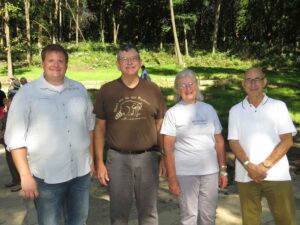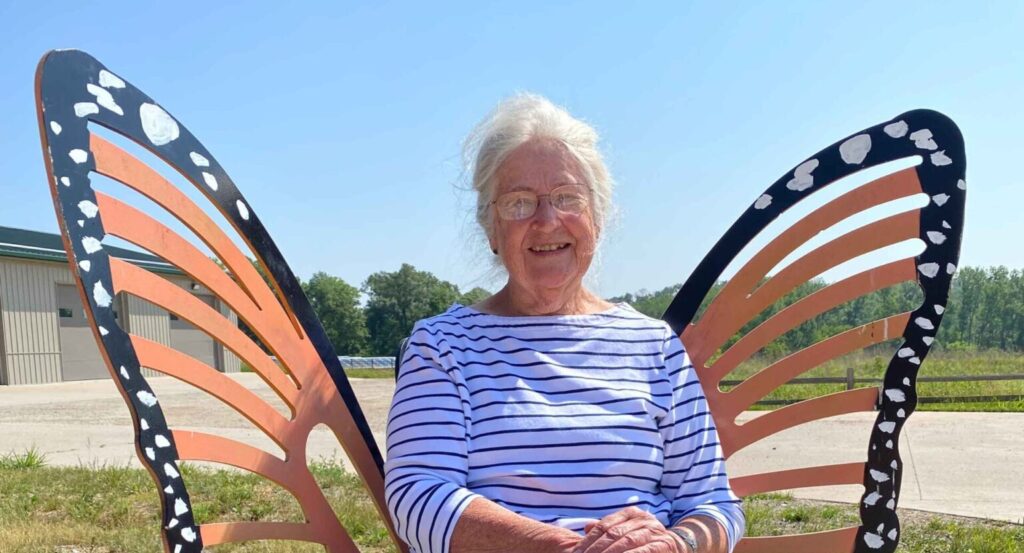Barb Perkinson – Barb Binhammer at the time – first served Indian Creek Nature Center as a volunteer, which segued into a role as the first naturalist on staff from 1974 to 1986. For several months in 1978 she filled in as interim director between the departure of Curt Abdouch and the arrival of Rich Patterson. When the Nature Center Guild was formed in 1975, Barb served as its vice president. She is a charter member of ICNC and became a lifetime member in 2016.
BECOMING A NATURALIST
“In 1973 my then-husband, Lee Binhammer, and I moved here (from Indiana), where he became a professor at Coe College and met (Coe biology professor and early ICNC board member) Floyd Sandford. I very soon heard from Floyd about a new nature center that was getting started. He thought I’d be interested because I had just gotten my master’s in conservation education (from Purdue University) – and yes, I was interested. So I contacted Curt Abdouch. First I was a trainee, and then I became the teacher-naturalist coordinator.”
From the Summer 1976 issue of the Indian Creek Nature Center newsletter: A new full time naturalist has joined the Nature Center. She is Barbara Binhammer. Barbara is well qualified, having a Masters Degree in Environmental Education and teaching experience at the high school level. Ms. Binhammer volunteered for two years as a Teacher-Naturalist. She has been hired on a grant awarded to the Nature Center from the Comprehensive Employment Training Act (CETA). Ms. Binhammer is a mother of four children and her husband, Lee, is a professor of sociology at Coe College.
“All you really need to teach about nature are people and a place. We never felt terribly challenged except when we were short on maintenance and we had to clean the bathrooms ourselves. The Center was a far cry from what it is today. But it was an exciting time of birth and development. It was just a lot of fun.”
From the Autumn 1976 issue of the Indian Creek Nature Center newsletter: Last year, Teacher-Naturalists provided leadership for 1,700 Cedar Rapids students and this year should see even greater numbers. After six to eight two-hour training sessions, Teacher-Naturalists are ready to meet the school buses and guide classes through a busy day’s learning activities in field, forest and stream. Teacher-Naturalists are enthusiastic about the rewards of their volunteer efforts. They tell us of their satisfaction in working with eager youngsters and in promoting environmental awareness and appreciation in a positive way. Inservice training opportunities throughout the year help Teacher-Naturalists continue to increase their knowledge of the outdoors and their interpretive skills.
“What am I most proud of? I would say those moments when you see the awakening in a child’s eyes. I saw that many times. And some of those youngsters went on to be botanists, professors, and so on. Some didn’t. But that was still the thing that was the most rewarding – and not necessarily only with children. But that would be the thing that I’ve always looked back on and been glad that I had the opportunity.”
From the Winter 1977 issue of the Indian Creek Nature Center newsletter: The Nature Center and its staff have been the recipient of three awards for involvement and achievement in environmental education. The first award was presented for the Junior Naturalist program sponsored by the Cedar Rapids-Marion Optimist Club. The program won a regional award in the Cultural-Educational category of Optimist-sponsored community and youth projects. The Junior Naturalist program is coordinated by staff naturalist Barb Binhammer.
“Programming was my job, so to speak. And I loved programming. When I was interim director (in 1978), B.B. Stamats came to me after a few months and asked if I would be interested in throwing my hat into the ring. I said, ‘No. I love programming. I love what I do.’ It was just great fun.”
SUMMER MEMORIES

“We used to take a group – fifth and sixth graders, I think – to Matsell Bridge as part of the summer program. We did an overnight so-called backpacking trip. There was a cabin up there. And so the kids would plan, and we would walk the mile or so up to the cabin. (Laughing) They always wanted to bring a watermelon, and we used to let them.
“By the end of the week, some of those kids were in tears when they had to leave each other. I’ll never forget how some of those groups bonded – you know, just being outdoors – so terrifically. Fun, fun, fun.
“We had a few snakes around that were easy to handle, such as a milk snake. There was a youngster who was just terrified of snakes. Absolutely terrified. At the end of the week the parents were invited to come out to a sharing session with the kids. This young man grabbed that snake and took it over to show his parents. He’d been so terrified, but within the span of a week he was now proud to present it to his parents. There are moments that you take with you forever.
“When we were at Matsell Bridge I’ll never forget: in a pile of wood that was next to the fireplace in a kind of open shelter there was some bioluminescence. The kids were spooked at first, when it got dark: ‘what’s glowing over there?’ And so we had a chance to talk about bioluminescence: how and where it occurs in nature and in the fire. There were always those kinds of things that happened that were totally unplanned and became part of the experience.
“I remember one very noisy, raucous group that didn’t settle down until like one o’clock in the morning, in spite of several admonitions. I was still awake. You never slept until everybody else was sleeping. When they were all finally asleep, a tree fell with a horrible crash. There was no wind, there was nothing going on. This huge tree just fell someplace. No one woke up. No one even stirred. I’ll never forget it.”
THE NEXT GENERATION OF NATURALISTS
Barb has a grandson, Noah, who loves exploring outdoors. “He enjoys catching frogs, and now I’m trying to get him to pay more attention: ‘What do we really have there? Let’s find out.’ We’re going to have our own BioBlitz (at my place). He’s such a learner.”
Who better to guide Noah on his nature journey than his grandmother, ICNC’s first naturalist?

